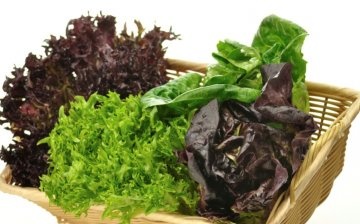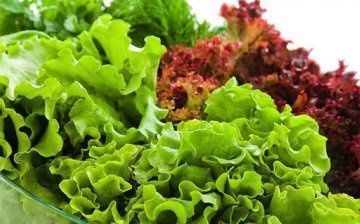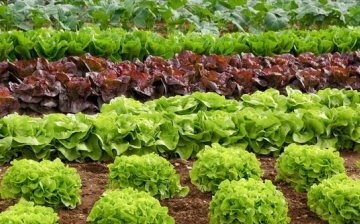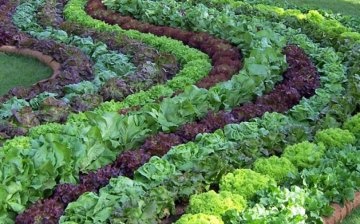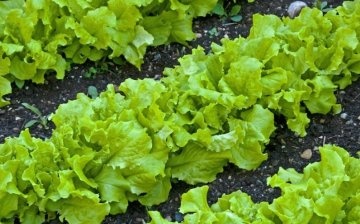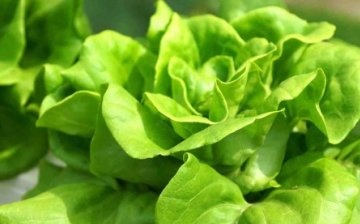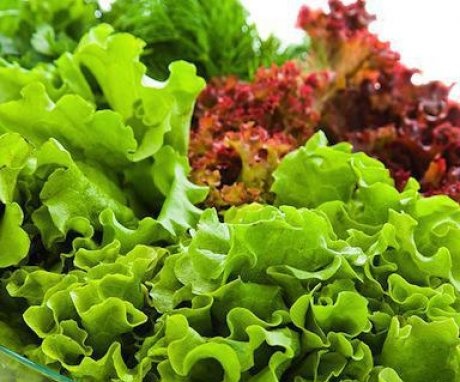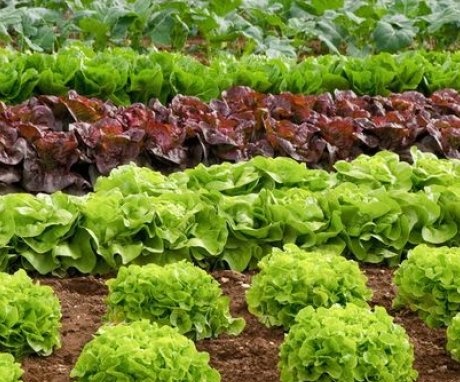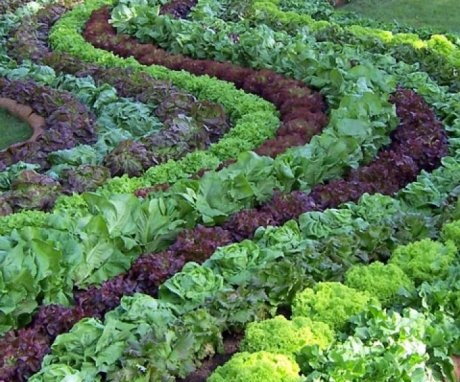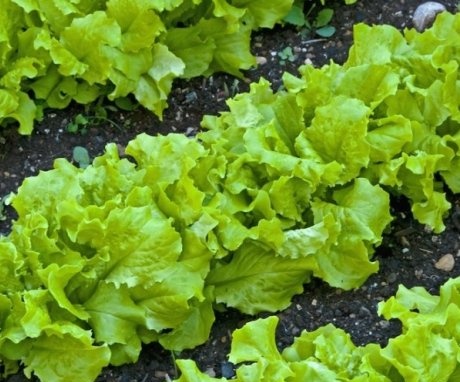Types of leaf lettuce - description and features of growing
Salad leafy from the Aster family - an annual plant. It is a small heads of cabbage with leaves of various shapes and all kinds of shades of green. The surface of the sheet is wavy, smooth, corrugated, curly. The brightness of the color and waviness of the leaves depends on the weather conditions: in the heat the leaves turn pale, at low temperatures, on the contrary, the color becomes saturated, the leaves are elastic and juicy. The stem of the lettuce branches out strongly, forming a large number of inflorescences. The root system is weak, close to the soil surface. Taproot.
Content:
Beneficial features
Salad lettuce or leafy takes pride of place in the ten most useful vegetables for humans. Lettuce contains more calcium and vitamin K (which plays an irreplaceable role in blood clotting) than all vegetables. And in terms of the composition of all minerals, this vegetable ranks second after spinach.
The high folate content is good for strengthening the immune system. As a source of magnesium, it has a beneficial effect on the nervous system, acts as a mild hypnotic. It helps to improve the digestion process, increases appetite.
Due to its low calorie content, lettuce is recommended for obese people.
Freshly squeezed lettuce juice improves brain activity. To prevent atherosclerosis, mix salad juice with the same amount of juice carrots, beets and turnips.
Types of lettuce
Salad leaf by ripening time is subdivided:
- Spring
- Summer
- Autumn
Spring is the earliest. They can be grown in open beds and in enclosed spaces such as greenhouses or greenhouses. Summer varieties tolerate heat well, they are sown from May to late July July. Autumn varieties perfectly tolerate a cool climate and lack of light, are not susceptible to diseases, even if they grow in greenhouses and greenhouses.
Early ripening varieties:
- Asterix - belongs to the oaky type, green leaves, delicate taste, erect rosette.
- Bohemia - leaves are green, wavy, wrinkled, oily. Ripens in a period of 30 - 40 days.
- Critset - leaves of light bright green color, delicate taste without bitterness. It tolerates heat well.
- Gourmand - leaves are yellow-green, wavy at the edges, wrinkled, leaf tissue is oily. Ripens in 40-45 days.
- Lollo-Biondo - corrugated leaves, juicy, crunchy. Can be grown all year round.
- Lollo-Rosa - leaves are brownish, burgundy, curly. Loves moisture, otherwise it may acquire a bitter taste.
- Moscow greenhouse - leaves are pale green with a slight yellowness, juicy, rosette up to 27 cm in diameter. A fairly common variety.
- An early ripening delicacy - the leaves are pale green, with a medium-bubbly surface, excellent taste.
- Furor - the leaves are wrinkled, large, along the edges of the "wave", buttery flesh.
- Relay - leaves with a reddish tint, strong "wave" at the edges, bubbly, excellent taste.
Mid-season varieties:
- Azaria - leaves are green, round, bubbly, large, along the edge of the "wave" with small cuts, the taste resembles young green peas.
- Apex - leaves are rounded, large, greenish at the root, purple to the edges, bubbly, buttery flesh. Low rosette about 12 cm.
- America - triangular leaves of a dark red hue, pleasant to the taste.
- Athlete - leaves are oily, rounded, purple. The rosette is slightly raised, similar to a loose head of cabbage.
- Vitamin exercise - great taste. Not afraid of low temperatures and lack of light.
- Green Manul - leaves are oily, rounded, wavy.
- Dachny - leaves are oily, thick, wrinkled, wavy along the edges, yellowish. Taste without bitterness.
- Dionysus - leaves are oily, even, oblong.
- Dubrava - belongs to the oaky type, the leaves are light green, large, the leaf surface is folded, the pulp is oily, delicate taste.
- Fun - oaky type, leaves are large, dissected, anthocyanin color, buttery flesh, excellent taste. It is characterized by high productivity.
- Emerald - the leaves are dark green, medium-bubbly, with a glossy surface, the flesh is oily. Great taste.
- Creed - large leaves, dark green, oily, pinnately dissected, delicate taste. Easily tolerates heat. Belongs to the oaky type.
- New Year's - the leaves are green. medium-bubbly, grown indoors, can be grown on a windowsill. High yield - about 3 kg of lettuce are harvested from one square meter.
- Riviera - similar to oak leaves, dissected, deep purple hue, large, buttery flesh.
- Northern blush - bubbly leaves, light green with purple splashes, excellent taste.
- Creator - the leaves are light greenish, wavy at the edges, fan-shaped, oily.
- Tornado - leaves with green with a yellowish tinge, wavy edge, crunchy, excellent taste.
- Fire - leaves are large, slightly bubbly, red, wavy edges with small incisions, buttery flesh, excellent taste.
Late-ripening varieties:
- Ballet - the leaves are dark green, strongly wavy along the edge, large, crunchy. It tolerates cold and lack of light well. The socket is flat. From the moment of germination to ripening, it takes about 34 days.
All of the listed varieties of lettuce are resistant to the formation of flowering stems (stemming), with the exception of the variety Apex and Moscow Greenhouse. All varieties can be grown indoors and outdoors.
Planting lettuce
Lettuce should be planted in well-lit beds in loosened, fertile, non-acidic soil. Lettuce requires a lot of potassium and nitrogen.
You can grow zucchini before the salad in the garden, cucumbers, cabbage and other plants that require a high content of organic fertilizers.
The salad area needs to be prepared in the fall.
If the soil was not fertilized, then when digging into it you need to add 1 sq. meter half a bucket of compost, 1 tablespoon of superphosphate, 1 tablespoon of potash fertilizers... If the soil is acidic, add ash. In the spring, to retain moisture in the soil, it must be loosened. Five to six days before sowing, loosen the soil again to a depth of about 12 centimeters, add ammonium nitrate (1 teaspoon per 1 square meter), level the beds, crushing large lumps.
In greenhouses, lettuce is best grown between or along the edges of the beds occupied by tomatoes or cucumbers... It is recommended to plant lettuce in the greenhouse two to three days before planting the main plants.
Lettuce is propagated in open beds seeds, occasionally - seedlings... Sowing lettuce can be started from April to the end of August, with an interval of fifteen days. In summer, it is recommended to sow late-ripening varieties that are resistant to the formation of flowering stems.
For planting, make furrows about 1.5 cm deep and about 15 cm apart.
The gap between seeds (by plants) must be at least 5 centimeters long. When the salad is cramped, the leaves become coarse. For better growth, you can add granular superphosphate (0.5 per 1 m2) when planting. Roll up the soil to speed up germination. Leaf lettuce can be sown between rows cabbage: it protects it well from the sun, and by the time the cabbage gets stronger, the salad can already be harvested.
Growing lettuce
Leaf lettuce does not require much maintenance - you need to regularly loosen the soil and clean weeds... Thin seedlings to form a good rosette.
The salad loves moist soil, but suffers from fungal diseases from excessive moisture, quality harvest while decreasing. Water a lot, but not very often, to avoid over-wetting the soil. At the same time, do not dry out.
The salad is very resistant to cold weather, it is not afraid of frosts down to minus 3 degrees.
If sockets (heads of cabbage) have managed to form - even up to minus 6 degrees. Autumn varieties can withstand the cold of minus 10 degrees. Lettuce varieties with pigmented leaves are most resistant to low temperatures. If the plant grows poorly, when two or three leaves appear, it must be fed with ammonium nitrate (0.5 tsp per 1 sq. M). It is important to remember that lettuce absorbs nitrates, so do not use fertilizer unless necessary.
Temperature range:
- For shoots, lettuce has enough temperature plus 2 degrees, for full development + 5 ° C.
- The best growth is achieved at plus 16-18 ° C during the day and 12-13 ° C at night.
Leaf lettuce tolerates a lack of moisture and heat worst of all. The leaves are small, rough, bitter. In hot climates, lettuce throws out arrows and leaves no leaves. Lettuce grows well under long, good lighting, especially for early ripening varieties. When the daylight hours are reduced, the formation of arrows slows down. The salad should not be planted thickly, as it stops developing.
Harvest
It is recommended to remove the salad after the appearance of six eight leaves, as later they coarse and become tasteless.
Collection harvest should be carried out in dry weather in the morning or evening.
Rinse the roots, the leaves themselves do not need to be washed - they will quickly rot. In the refrigerator, the salad can be stored for up to fifteen days, at room temperature - no more than a day.
You don't have to pull out the rosettes with the roots, but cut off the leaves. Then new ones grow in their place, and the fruiting period increases. You will get more than one harvest from one site. Wonderful properties lettuce, the presence of varieties of different early maturity allows grow its almost all year round.
More information can be found in the video.



